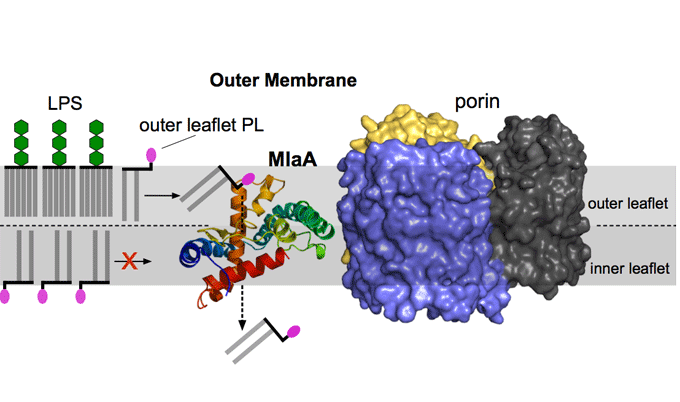Asymmetry in bacteria
The importance of asymmetry in bacteria
Published on: 16 October 2017
New research published in Nature Microbiology has highlighted a protein that functions as a membrane vacuum cleaner and which could be a potential new target for antibiotics.
The Newcastle University team reveal how the removal of certain lipids from the outer membrane may provide a vulnerability for gram-negative bacteria. They propose that this system could be exploited by drugs to decrease bacterial virulence, and to make various antibiotics more effective.

Cleaning the bacterial membrane
Gram-negative bacteria such as E. coli have two membranes, an inner membrane and an outer membrane.
The outer membrane is an asymmetric bilayer with an inner leaflet of phospholipids and an outer leaflet composed almost exclusively of lipopolysaccharide.
The lipopolysaccharide forms a sugar-coated layer on the surface of Gram-negative bacteria that is a very effective barrier for greasy, hydrophobic molecules and causes resistance towards antibiotics and other harmful compounds.
However, phospholipids from the inner leaflet spontaneously accumulate in the outer leaflet of the outer membrane, forming "islands" amid the lipopolysaccharide that increase the outer membrane permeability of toxic compounds. Those phospholipid molecules need to be removed from the outer leaflet to restore the outer membrane permeability barrier and asymmetry.
This process is carried out by the maintenance of lipid asymmetry (Mla) system, which is present in most Gram-negative bacteria. The MlaA protein, the focus of the research, is the outer membrane component of the Mla system.
Lead author and Professor of Membrane Protein Structural Biology within the Institute for Cell and Molecular Biosciences at Newcastle University, Bert van den Berg explained: “Our three-dimensional structures and functional data show that MlaA forms a donut in the inner leaflet of the outer membrane. This binds phospholipids from the outer leaflet and removes these via the central channel, somewhat similar to a vacuum cleaner.
“Our study illuminates a fundamental and important process in Gram-negative bacteria and is a starting point to determine whether the Mla system of Gram-negative pathogens could be targeted by drugs to decrease bacterial virulence, and to make various antibiotics more effective.”
The research leading to these results was conducted as part of the Translocation consortium and has received support from the Innovative Medicines Initiatives Joint Undertaking.
The Institute for Cell and Molecular Biosciences aims to support and develop the highest quality research to understand fundamental features of the working cells placing special emphasis on problems relevant to medicine. The team from the Institute working with their international collaborators will now continue study of the MlaA protein as a target for antiobiotics.
Reference: Structural basis for maintenance of bacterial outer membrane lipid asymmetry. Javier Abellón-Ruiz, Shreyas S. Kaptan, Arnaud Baslé, Beatrice Claudi, Dirk Bumann, Ulrich Kleinekathöfer and Bert van den Berg. Nature Microbiology. Doi: 10.1038/s41564-017-0046-x
Image shows cleaning of the outer membrane by MlaA. MlaA, which in the cell is bound to another outer membrane protein called a porin, removes outer leaflet phospholipids and functions like a membrane vacuum cleaner that maintains the important outer membrane permeability barrier.
Heading 3 example
Text only. For subheading use ‘Heading 3’
Lorem ipsum dolor sit amet, consectetur adipiscing elit. Donec vel sapien lectus. Aliquam consectetur vitae tortor mattis sodales. Donec id quam id nulla tristique vestibulum. Ut vitae orci aliquam massa varius dapibus. Vivamus aliquet, lorem sit amet semper ultricies, ex tortor molestie felis, at ultrices tellus ligula vitae est. Sed gravida tortor sapien, in iaculis quam vestibulum vel. Duis et quam nec metus pharetra placerat. Donec in tellus pretium ex sagittis posuere. Nunc varius, libero at suscipit commodo, magna lacus facilisis velit, sed pellentesque magna eros vel dolor. Donec pretium neque ultrices, condimentum turpis non, porttitor neque. Suspendisse fermentum at lectus scelerisque mattis. Nam augue justo, iaculis quis euismod et, viverra in elit. Aliquam vitae justo malesuada, sodales urna et, aliquam nunc. Nulla placerat neque quis odio molestie, mattis bibendum turpis pellentesque.



